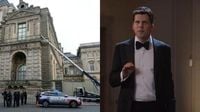On October 19, 2025, the Louvre Museum in Paris—one of the world’s most iconic cultural institutions—was rocked by a daring daylight robbery. The target? None other than the crown jewels, valued at a staggering $108 million. As police cordoned off the museum and investigators scrambled for leads, an unexpected twist turned the crime scene into a global social media sensation: a single photograph of a mysterious, well-dressed man in a fedora, snapped just outside the museum gates.
The image, captured by Associated Press photographer Thibault Camus, wasn’t intended to be a showstopper. Camus himself later admitted, “It wasn’t even a particularly great photo. He appeared in front of me, I saw him, I took the photo. He passed by and left.” Yet, in the hours after AP distributed the photo, the internet did what it does best—spun myth out of the mundane. The man’s classic coat, tie, and fedora conjured instant comparisons to Inspector Clouseau of the Pink Panther films and the hardboiled detectives of 1940s film noir. Social media posts exploded, with captions like, “Actual shot (not AI!) of a French detective working the case of the French Crown Jewels that were stolen from the Louvre.”
One viral post went further, boldly declaring, “The man in the fedora, who looks like he came out of a detective film noir from the 1940s is an actual French police detective who’s investigating the theft of the Crown Jewels at the Louvre. Pure aesthetic.” Another user, Melissa Chen, joked, “To solve it, we need an unshaven, overweight, washed-out detective who's in the middle of divorce. A functioning alcoholic who the rest of the department hates. Never gonna crack it with a detective who wears an actual fedora unironically.” The memes and speculation only intensified, with TikTok user alliebunn_ gushing, “Yes I’m romanticizing this, it’s the most exciting news we’ve got in a WHILE!”—her post racking up over five million views, according to The Economic Times.
The real story, however, was far less cinematic. The AP’s original caption made no mention of detectives, simply noting, “Police officers block an access to the Louvre Museum after a robbery Sunday, Oct. 19, 2025, in Paris.” Camus later clarified to The New York Times that the man was just an unidentified passerby, likely one of many people evacuating the area after the heist. “Old-fashioned like a museum can be,” Camus mused about the man’s attire, which seemed to blend perfectly with the Louvre’s storied backdrop. Other people appeared in Camus’s photos that day—including a woman in a Yankees hat—but none captured the internet’s collective imagination quite like the fedora-wearing stranger.
As the photograph went viral, the Paris prosecutor’s office seemed to enjoy the swirling mystery, responding to an AP inquiry with a playful, “We’d rather keep the mystery alive ;)” The man’s identity remains unknown, and he has yet to step forward, leaving the world to wonder whether he was an accidental muse or an undercover sleuth hiding in plain sight.
Meanwhile, the real investigation into the Louvre heist pressed on. Paris public prosecutor Laure Beccuau revealed in an interview with French radio station RTL that about 100 investigators had been assigned to the case, all working feverishly to recover the missing jewels. “The jewels' whereabouts, the robbers' intentions and their identities are all still unknown,” Beccuau said, underscoring the challenge facing authorities. The theft has not only embarrassed French officials but has also exposed serious flaws in the security protocols of one of the world’s most visited museums, as reported by The Economic Times.
Security experts and former jewelry thieves alike have weighed in, suggesting that such a sophisticated robbery almost certainly required inside help. One former thief, speaking on October 25, 2025, speculated, “Let me tell you, they had an inside person. An inside person doesn’t mean they even know him. Could it be a girlfriend who’s a tour guide, and she knows, oh, where it is?” The notion that someone with privileged knowledge aided the robbers has only deepened public intrigue and raised uncomfortable questions for museum administrators worldwide.
The heist’s cultural impact has reverberated far beyond the art world. Social media, always quick to seize on a good story, transformed the event into a meme factory, with users concocting elaborate detective backstories for the fedora-clad passerby. Some, like influencer Ian Miles Cheong, racked up tens of thousands of views, while others took the story in a more tongue-in-cheek direction, referencing fictional detectives or even suggesting the robbery was an elaborate PR stunt for an upcoming film. According to The Financial Express, a viral conspiracy theory posited that the theft was actually a promotional event for movies like 'Now You See Me 3' or 'Ocean’s 14.' While there’s no evidence to support such claims, the theory’s popularity highlights the public’s fascination with high-stakes crime—and its penchant for blending reality with fiction.
All the while, the Louvre remains under intense scrutiny. The museum, which has long been a symbol of French national pride and a magnet for millions of tourists, now faces tough questions about its ability to safeguard priceless cultural treasures. Experts warn that this brazen heist could trigger a comprehensive overhaul of museum security not only in Paris but across the globe. If the world’s most famous museum can fall victim to such a theft, what does that mean for other institutions housing irreplaceable works of art?
The case has also become a litmus test for how quickly narratives can be spun—and believed—in the digital age. A single photograph, taken in the chaos of a crime scene, became a viral sensation and a symbol of the intrigue surrounding the heist. The line between fact and fiction blurred, as millions chose to believe in the legend of the fedora-wearing French detective, even as the truth remained far more prosaic.
As of October 25, 2025, the stolen crown jewels have yet to be recovered. The identities and motives of the thieves remain a mystery. The Louvre, for its part, is left to reckon with not only the loss of invaluable treasures but also the reality that, in an era of instant communication and viral memes, even a simple photograph can become a cultural phenomenon. For now, the world waits—wondering if the real story behind the Louvre heist will ever be as captivating as the myth that now surrounds it.
Sometimes, it’s the stories we tell ourselves—and the images that capture our imagination—that linger longest after the crime scene tape comes down.






